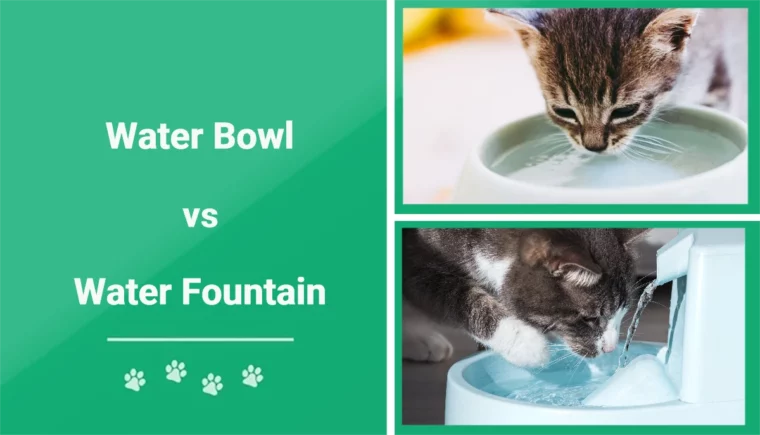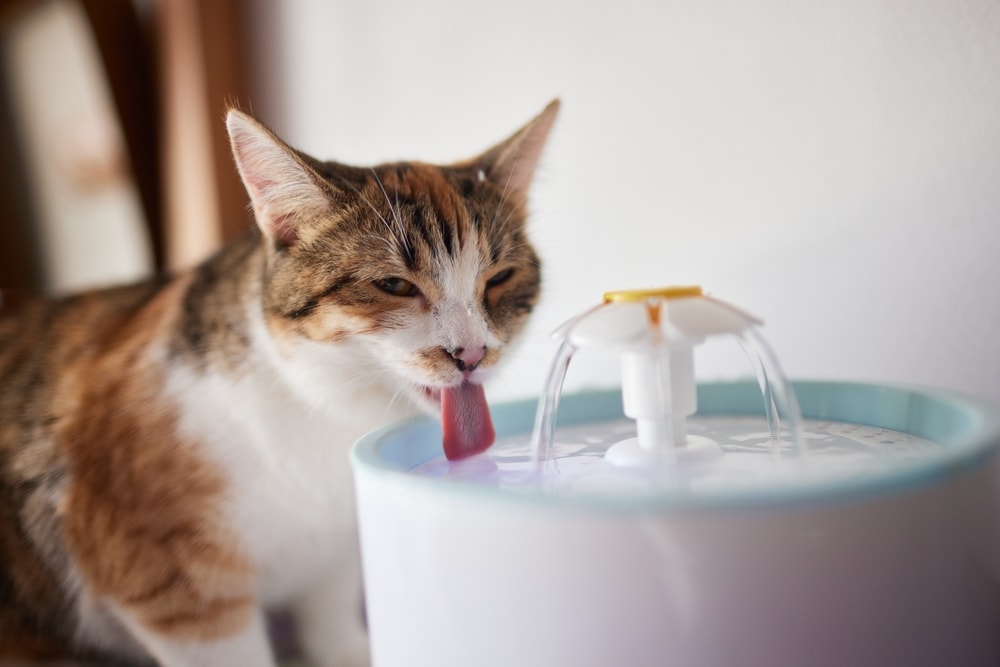
Proper water intake is essential in maintaining a cat’s healthy, active, and fulfilling lifestyle, and your presentation can make all the difference in how they take to it. Satisfying a fussy cat is easier than ever nowadays since plenty of options improve upon the mundane water bowl to promote healthy drinking.
Cat water fountains are revolutionizing the way our pets hydrate. The active flowing water entices cats to drink, which makes it a perfect solution when your cat is picky. But fountains aren’t superior to bowls in every way, so before you go tossing out all of our water bowls, let’s have a look at all the pros and cons of water fountains vs. bowls.
Visual Differences

At a Glance
Water Bowl

The simple and reliable solution. Available in numerous sizes and materials, including stainless steel, plastic, and ceramic, so you can cater to your cat’s preference. Water can stagnate in the bowl, allowing it to dirty quickly and requiring frequent water changes.
Maintenance
Cat bowls require daily cleaning and water changes, but they are quick and easy to do. They’re quick to refill, and most of them can go in the dishwasher, so cleaning them every couple of days is rarely a challenge.
Versatility
Lacking a plug and taking up little space, cat water bowls can go anywhere you need. If your cat relocates upstairs or outside, it’s easy to take their dish and find a space. Bowls are the obvious choice when traveling, and they’re the simplest to pack, pull out, and use without making a mess.
Cats often indulge in a little water play - whether it be pawing at their water bowl or dribbling while taking a drink, it creates a mess of their feeding area and their pet parents' floors. The Hepper NomNom Cat Bowl was created with these silly cat habits in mind. It offers a spill-proof design and features a wide tray specifically made to catch any splashes that may occur. The two stainless steel bowls fit securely into the PP plastic base ensuring their food and water stay exactly where you want them. Combat spills by bringing home the Hepper NomNom Cat Bowl.
At Pet Keen, we’ve admired Hepper for many years and decided to take a controlling ownership interest so that we could benefit from the outstanding designs of this cool cat company!
Water Fountain

A cat water fountain consists of a basin, pump, filter, and head where water flows out. The automatic waterer continuously pumps water from a reservoir and up through a head, where it cascades down into a basin from which the cat can drink. The water keeps moving, stays oxygenated, and maintains its freshness. There is a huge range of different styles, designs, and prices available, so you should be able to find one that suits your cat, your home, and your budget!
Water usually flows through a multi-stage filter system before emerging from the spout. The filter often includes a carbon filter to remove Volatile Organic Compounds (VOC) and treatment chemicals, a foam or mesh filter to separate hair and debris, and an ion exchanger to soften water by removing natural minerals.
With a cat fountain, water comes out cleaner, cooler, and better-tasting, while the movement and gentle sound is appealing and encourage interaction. If you have a picky pet, a cat drinking fountain can overcome any potential objection.
Maintenance
Water fountains are an excellent option for multi-cat households, where smaller water bowls can get empty or dirty quicker.
The downside to cat water fountains is that, while they require more infrequent maintenance, the maintenance is much more involved. They have filters that need occasional changing, and many designs are not dishwasher-safe. You often have to disassemble the unit, including interior components like the pump assembly, and hand-wash them to remove biofilm and other dirty buildup. Manufacturers usually recommend cleanings like this every 1-2 weeks.
Versatility
Pet fountains are more versatile than cat water bowls in some ways and less versatile in others. On the plus side, they can be a boon to a multi-cat household. Numerous designs use several spouts in the head to give each cat a personal drinking fountain, and the constant circulation keeps it fresh and clean for all involved. Plus, many fountains present water at several stages, accommodating cats of all sizes and ages. Older cats can comfortably drink at an elevated height, and kittens can access water nearer the floor.
At the same time, most fountains can’t fit in the same spaces as standard water bowls. Needing power, they must always be in proximity to an outlet. They’re also bulkier and more cumbersome, allowing for fewer possible spaces where they can fit. And while the operation is often whisper-quiet, they may still disturb you if you keep it near your bedroom or workstation. A powered water fountain isn’t the best pick if you need a reliable “go anywhere” solution to hydrate your cat.
Finding a great water fountain that you and your cat will both love is harder than it sounds.
We recommend Hepper's Stainless Steel Cat Water Fountain, a beautifully designed option with triple filtration, adjustable flow modes, and a conveniently large capacity. This fountain is easy to clean (many parts are even dishwasher-safe!) and sturdy enough to last for years.
At Pet Keen, we've admired Hepper for many years, and decided to take a controlling ownership interest so that we could benefit from the outstanding designs of this cool company!
Type of Water Fountains
Cat water fountains vary considerably in size, material, and design. Some fountains have a faucet-like head that pours water into a basin. Many have multiple spouts, often in a 360° style allowing several cats to drink at once. Other versions have water that flows gracefully and quietly down a ramp. Gravity-driven water fountains aren’t powered but have a large tank instead that constantly adds more water to the bowl as your cats drink.
There are all kinds of innovations in cat water fountains, giving you several cool features to enhance the experience for you and your cat. You can find dishwasher-safe units with upgraded filtration systems or adjustable flow rates to please picky cats. Some even have innovative attractants like catnip holders and attachable cat wands, proving there’s no limit to how you can enhance your pet’s enjoyment.

How Much Do Cat Water Fountains Cost?
The most expensive water fountains cost over $100, but you can easily find numerous quality units for under $50. However, you also have to consider the ongoing costs of replacement filters. Automatic waterers need filter changes about one or two times every month. Although you can usually get a few months’ worth of replacements for under $30, you have to consider the accumulated cost and the occasional aggravation of needing to order the parts, which are often proprietary.
Do Water Fountains Work?
The primary selling point of cat water fountains is that they encourage more drinking in several ways. The water is always clean and channeled through a multi-stage filter, with the aeration from motion adding a sensation of freshness. The flow supposedly also mimics the normal drinking situation in nature, which could be more appealing to a cat’s instinct. Regardless of a cat’s desire to consume water, the flow is at least entertaining and often able to coax interaction with your pet, hopefully making it easier for them to start drinking.
With all those aspects supposedly working in their favor, do water fountains increase the chances of a cat drinking? There is very little in the way of scientific data or research into this topic. Anecdotally, it seems that cats are at least more attracted to a water fountain than a regular water bowl, but whether this necessarily equates to them drinking more is difficult to say with any certainty.
What we do know is that cats do have preferences when it comes to what they want to drink from. Generally speaking, cats prefer bowls that are:

If you have a cat that doesn’t seem to spend much time at the water bowl, it may be that they get a lot of their moisture requirements from their food, but it might be that they are not impressed with how their water is being presented.
Investing in a water fountain is certainly one way to increase your cat’s interest in their water, which will hopefully translate into drinking more water. But, a water fountain isn’t the only option out there, so it’s worth doing your homework and deciding which options might work best for you.
Conclusion
Cat water bowls and fountains have unique benefits, and each fits different lifestyles and needs. But while we may consider how their pros and cons affect us, the most crucial consideration is your cat’s preference. No matter which one you like, it will never do you any good if your cat refuses to drink from it. In many cases, it takes trial and error. But if you frequently struggle to keep your cat hydrated and their dish fresh, a water fountain is a low-risk investment that could address your feline hydration problems.
Featured Image Credit: Top – PicksArt, Shutterstock | Bottom – Creative Cat Studio, Shutterstock











